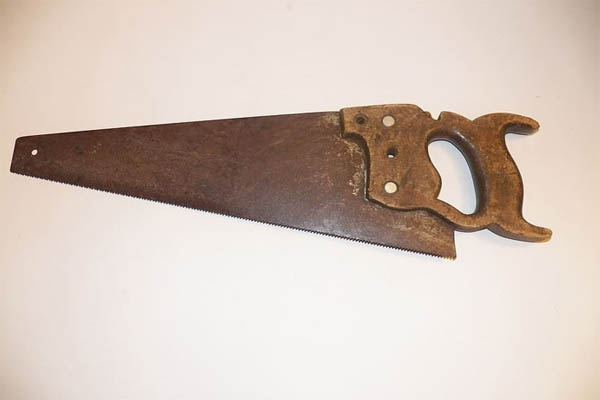Exploring the Diverse World of Handsaws: A Comprehensive Guide
In the realm of woodworking and various DIY projects, the selection of tools plays a pivotal role in determining the outcome of your endeavors.
Among the essential tools in a woodworker’s arsenal, the handsaw holds a place of prominence.
With a diverse array of handsaw types catering to specific tasks, it’s crucial to acquaint yourself with their individual characteristics and purposes.
In this comprehensive guide, we delve into the world of handsaws, exploring the different types that empower craftsmen to achieve precision and excellence in their creations.
The Role of Handsaws in Woodworking
Handsaws have been an integral part of human craftsmanship for centuries. Unlike power saws that rely on electricity, handsaws are powered by the craftsman’s strength and skill.
This manual approach not only provides a deep connection to the woodworking process but also offers greater control over the cuts, making them a preferred choice for many woodworking enthusiasts.
Types of Hand Saws
1. Rip Saw

The rip saw, a classic among handsaws, is designed for one primary purpose: cutting wood parallel to the grain.
Its distinguishing feature is its large and coarse teeth that effectively tear through wood fibers, making it ideal for tasks like dimensioning lumber or planks.
The rip saw’s cutting action is more aggressive, requiring the user to put in greater effort, but it excels at making long, straight cuts with precision.
2. Crosscut Saw

Contrary to the rip saw, the crosscut saw is tailored for cutting wood across the grain. This saw features smaller and finer teeth compared to the rip saw.
These fine teeth create cleaner, more accurate cuts that are perpendicular to the wood’s natural grain direction.
This makes crosscut saws indispensable for projects that require precise sizing and fitting.
3. Back Saw

For those seeking precision and finesse in their cuts, the back saw is an essential tool.
What sets the back saw apart is its rigid spine or back that prevents the blade from flexing during cuts.
This rigidity, combined with fine teeth, enables controlled and accurate cuts. Back saws are widely used in fine joinery work, such as creating dovetail joints and tenons.
4. Coping Saw

When intricate curves and patterns in wood are the order of the day, the coping saw steps into the spotlight.
Its thin blade and adjustable frame allow for precise maneuvering, making it a favorite among woodworkers engaged in detailed scrollwork.
Coping saws excel at making interior cutouts, allowing for intricate designs that would be challenging to achieve with other types of saws.
5. Hacksaw

Moving beyond wood, the hacksaw is a versatile tool designed for cutting through various metals.
With its fine-toothed blade and sturdy frame, it’s perfect for tasks involving pipes, rods, and other metal components.
The hacksaw’s design ensures that it can handle the rigors of metal cutting, producing clean and accurate cuts even in harder materials.
6. Keyhole Saw

When it comes to creating small, intricate holes and cutouts in wood, the keyhole saw takes center stage.
This saw is recognized by its narrow and pointed blade, which allows it to navigate tight corners and confined spaces.
Woodworkers often use the keyhole saw to make openings for locks, keyholes, and other similar features.
7. Pruning Saw

Gardening and landscaping enthusiasts will find a reliable companion in the pruning saw.
Designed for outdoor tasks, this saw features coarse teeth and an aggressive cutting action.
It’s perfectly suited for cutting tree branches, shrubs, and other greenery, making yard maintenance a breeze.
8. Japanese Saw

The Japanese saw, or “pull saw,” stands out due to its unique design.
Unlike traditional saws that cut on the push stroke, the Japanese saw’s teeth are designed to cut on the pull stroke.
This design minimizes blade flex and allows for fine and accurate cuts.
The Japanese saw is a favorite among woodworkers for both woodworking and fine joinery, offering a different experience compared to Western-style saws.
9. Tenon Saw

Creating strong and seamless joints is a cornerstone of woodworking, and the tenon saw plays a crucial role in this process.
With fine teeth and a rigid back, the tenon saw is tailored for cutting tenon joints.
Its precise cuts ensure that these joints fit together snugly and securely, contributing to the overall strength and integrity of the piece.
10. Miter Saw

Achieving precise angle cuts is a hallmark of advanced woodworking, and the miter saw is designed to fulfill this role.
Also known as a “mitre saw,” it specializes in making accurate angle cuts, typically at 45-degree or 90-degree angles.
Miter saws are commonly used in tasks such as framing, trim work, and other projects where precise angles are essential.
11. Carcass Saw

Sitting at the crossroads of crosscut and rip saws, the carcass saw offers a versatile cutting experience.
It features fine teeth for clean cuts and a rigid back for added stability.
Carcass saws are often used in cabinetmaking and furniture construction, where they excel in making both long cuts and crosscuts.
12. Panel Saw

The panel saw is a workhorse when it comes to breaking down large sheets of plywood or other panel materials.
With large teeth and a long blade, this saw ensures efficient and clean cuts.
Panel saws are essential for projects that involve cutting down large panels into smaller, more manageable pieces.
13. Fret Saw

For woodworking projects that demand intricate and detailed cuts, the fret saw steps up to the plate.
Similar to the coping saw, it’s designed for detailed work, such as crafting musical instruments and creating intricate artwork.
The thin blade of the fret saw allows for tight curves and delicate cuts.
14. Bow Saw

While many handsaws focus on woodworking, the bow saw stands as a versatile tool that caters to both wood and other materials.
Its sturdy frame and wide blade make it a suitable choice for outdoor tasks, such as cutting green wood, branches, and even logs.
Bow saws are particularly popular among those engaged in camping, gardening, and outdoor maintenance.
15. Compass Saw

When it comes to making curved cuts and holes in wood, the compass saw takes the spotlight.
Its blade is designed for maneuvering tight curves, making it an essential tool for projects that involve creating intricate shapes or patterns.
From crafting wooden toys to detailed artwork, the compass saw finds its place in various creative pursuits.
16. Veneer Saw

The veneer saw addresses the delicate task of cutting thin veneer sheets with precision.
Its fine teeth and delicate design ensure that clean and accurate cuts can be made without damaging the fragile veneer.
Veneer saws are crucial for projects that involve veneering, marquetry, and other applications where thin wood layers are used.
17. Dovetail Saw

Creating dovetail joints is a hallmark of woodworking craftsmanship, and the dovetail saw is tailor-made for this purpose.
With fine teeth and a thin blade, the dovetail saw excels in cutting dovetail joints with precision.
These joints are not only functional but also decorative, adding a touch of elegance to furniture and other woodworking projects.
Choosing the Right Handsaw for the Task
Each type of handsaw has been meticulously designed to cater to specific tasks, ranging from cutting wood along or across the grain to creating fine joinery, making curved cuts, or even pruning branches.
Selecting the appropriate handsaw for a given task is essential to achieve accurate and efficient cuts.
Using the wrong type of saw not only hampers your progress but also leads to less-than-desirable results.
When selecting a handsaw, consider the following factors:
- Task at Hand: Determine the type of cut you need to make. Is it a straight cut, a curve, or an angled cut? The nature of the cut will dictate the type of saw you should use.
- Material: Consider the material you’ll be working with. Different materials require different types of saws. For instance, a hacksaw is suitable for metal, while a coping saw is better for intricate woodwork.
- Precision: If precision is crucial, opt for a saw with finer teeth and a rigid back. These features contribute to cleaner and more accurate cuts.
- Ease of Use: Some saws are easier to maneuver than others. If you’re a beginner, consider starting with a saw that offers greater control and is forgiving of slight errors.
- Experience Level: As you gain experience in woodworking, you’ll develop a preference for certain saws based on their feel and performance. Over time, you’ll refine your skills and become more comfortable with various types of saws.
Conclusion
In the world of woodworking, handsaws are more than mere tools—they are extensions of the craftsman’s skill and vision.
Each handsaw type serves a specific purpose, whether it’s achieving precise cuts, crafting intricate patterns, or tackling outdoor tasks.
Choosing the right handsaw for a given project is a crucial step in ensuring accurate and efficient cuts.
By familiarizing yourself with the diverse types of handsaws available and their unique features, you equip yourself with the knowledge needed to elevate your woodworking projects to new levels of craftsmanship and excellence.
So, whether you’re an experienced woodworker or an aspiring DIY enthusiast, let the handsaw be your trusted partner on the journey of creating beautiful and functional pieces that stand as a testament to your dedication and creativity.

Don Kerr spent many years honing his skills as a DIY woodworker. He finds immense joy in not only creating remarkable pieces but also in generously sharing his knowledge. Connect with him via group.



